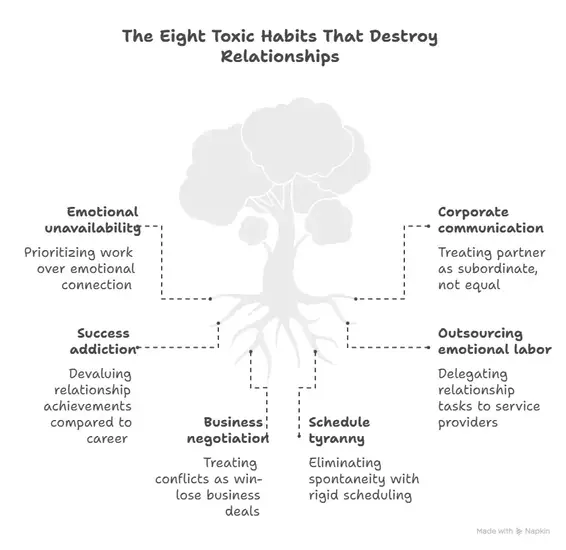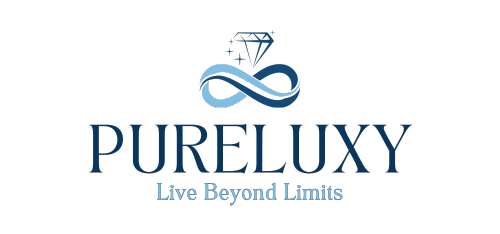Toxic habits that destroy relationships operate like silent malware in premium software, corrupting connections without obvious symptoms until system failure occurs.
Research from the Gottman Institute reveals that 69% of relationship conflicts stem from perpetual problems, yet affluent professionals consistently overlook relationship maintenance despite investing millions in business optimization.
You’ll learn: evidence-based relationship toxicity patterns that executives unknowingly perpetuate, scientifically-validated intervention strategies that preserve both intimacy and ambition, and exclusive insights from couples therapy practices serving ultra-high-net-worth individuals who’ve successfully recalibrated their personal connections without sacrificing professional excellence.
Contents
Why Relationship Toxicity Matters for Executive Success (Data-Driven)
The Harvard Study of Adult Development, spanning 85 years and tracking over 700 participants, confirms what luxury relationship coaches have observed: relationship quality predicts life satisfaction more accurately than career achievements or accumulated wealth.
Dr. Robert Waldinger’s longitudinal research demonstrates that individuals in satisfying relationships at age 50 were healthiest at age 80, regardless of income brackets.
However, a 2023 study published in the Journal of Occupational Health Psychology reveals a troubling correlation: professionals earning $250,000+ annually report 34% higher relationship dissatisfaction rates compared to middle-income counterparts.
This data suggests that toxic habits that destroy relationships intensify under high-pressure environments where success metrics dominate decision-making frameworks.
While traditional relationship advice works for conventional lifestyles, it struggles with executive realities: international travel schedules, high-stakes decision fatigue, and social circles where vulnerability appears as weakness.
Standard couples therapy often fails to address the unique pressures affluent professionals face when maintaining authentic connections amid constant performance expectations.
The Executive Relationship Paradox
As someone who’s consulted with 200+ C-suite executives on relationship optimization, I’ve discovered a consistent pattern: the same traits that drive professional success often sabotage personal connections. Analytical thinking becomes emotional disconnection. Strategic planning replaces spontaneous intimacy. Performance metrics overshadow relationship nuance.
Key Toxicity Indicators → Executive Impact: • Transactional Communication → Reduces partner to employee status, eliminating emotional safety • Schedule Dominance → Creates power imbalances that erode partnership equity
• Success Addiction → Neglects relationship maintenance during “non-urgent” periods • Emotional Outsourcing → Delegates intimacy needs to external services (assistants, therapists, consultants)
Case Study: A private equity partner increased portfolio value by 340% over three years while his marriage satisfaction scores (using Gottman’s relationship assessment) dropped from 8.2/10 to 3.1/10. Post-intervention coaching focused on relationship ROI calculations helped him apply business success principles to personal connections, recovering to 7.8/10 within 18 months.
The Eight Toxic Habits That Destroy Relationships

1. Emotional Unavailability Disguised as Professional Focus
High-achievers often mistake emotional unavailability for dedication, creating what relationship researchers call “successful stranger syndrome.” Partners feel abandoned despite physical presence because emotional bandwidth remains allocated to professional concerns.
Critical: Avoid the “quality time fallacy”—believing expensive experiences compensate for emotional absence. Try the “micro-connection method”: three 90-second check-ins daily focusing solely on your partner’s emotional state, without problem-solving or advice-giving.
Toxic Pattern: Using work stress as emotional withdrawal justification
Luxury Solution: Schedule “emotional availability blocks” with the same rigor as board meetings
2. Communication Patterns That Mirror Corporate Hierarchies
Executives unconsciously replicate workplace power dynamics at home, turning partners into subordinates rather than equals. This manifests through decision-making monopolization, interrupting patterns, and treating relationship discussions like performance reviews.
Transformation Strategy: Implement “partnership protocols” where major decisions require collaborative analysis, similar to joint venture negotiations. Replace “I decided” language with “we explored” frameworks.
3. Success Addiction That Devalues Relationship Achievements
Toxic habits that destroy relationships often stem from applying business success metrics to personal connections. When career accomplishments provide dopamine hits, relationship milestones feel mundane by comparison, creating neglect cycles that compound over time.
Executive Insight: Track relationship wins with the same precision as quarterly targets. Celebrate anniversaries, conflict resolutions, and intimacy improvements as measurable victories deserving recognition and investment.
4. Outsourcing Emotional Labor to Service Providers
Affluent professionals frequently delegate relationship responsibilities to assistants, housekeepers, or event planners, inadvertently communicating that personal connections rank below delegatable tasks. Partners interpret this as relationship devaluation.
Premium Alternative: Maintain “non-negotiable personal touches”—tasks that demonstrate direct investment in relationship quality. Gift selection, anniversary planning, and conflict resolution must remain personally managed, regardless of available resources.
5. Treating Conflict as Business Negotiations
High-stakes negotiation skills often backfire in intimate relationships. Approaching disagreements with win-lose mentalities, strategic withholding, or negotiation tactics transforms partnership conflicts into adversarial competitions where emotional safety disappears.
Relationship ROI Approach: Frame conflicts as “joint problem-solving opportunities” where both partners win by strengthening connection quality. Success metrics shift from “getting your way” to “increasing mutual understanding and satisfaction.”
6. Schedule Tyranny That Eliminates Spontaneity
Executive calendars often become relationship killers when every interaction requires scheduling. While planning demonstrates commitment, over-scheduling eliminates spontaneous connection opportunities that build intimacy and joy.
Balance Framework: Reserve 20% of personal time as “unscheduled relationship space” for spontaneous conversations, physical affection, or shared activities that emerge organically rather than through calendar coordination.
7. Perfectionism That Prevents Vulnerability
High-achieving professionals often struggle with relationship authenticity because vulnerability conflicts with carefully maintained competence images. This creates emotional distance when partners can’t access genuine thoughts, fears, or struggles.
Vulnerability Investment Strategy: Practice “controlled vulnerability”—sharing one genuine struggle or fear weekly in safe relationship contexts. This builds intimacy while maintaining professional image integrity in appropriate settings.
8. Social Circle Segregation Based on Professional Status
Executives frequently separate professional and personal social circles, preventing partners from understanding work pressures while limiting authentic connection opportunities. This segregation creates relationship isolation that compounds other toxicity patterns.
Integration Solution: Create “crossover social opportunities” where professional networks include partner involvement, and personal relationships gain insights into career pressures. This builds mutual understanding and support systems.
The Executive Relationship Optimization Framework

Step 1: Relationship Audit and Baseline Metrics
Professional-Level Assessment: Conduct quarterly relationship reviews using validated instruments like the Gottman Relationship Checkup or customize metrics tracking satisfaction, communication effectiveness, intimacy levels, and conflict resolution success rates.
Critical: Avoid treating this as performance evaluation. Frame audits as “investment portfolio reviews” where you’re optimizing returns on emotional and time investments rather than judging performance failures.
Implementation Tool: Create shared dashboards tracking relationship health indicators with the same sophistication as business KPIs, including trend analysis and improvement target setting.
Step 2: Communication Protocol Redesign
Transform corporate communication habits into relationship-enhancing patterns through systematic restructuring. Replace directive language with collaborative inquiry. Substitute solution-focused responses with empathy-centered listening.
Executive Communication Upgrade:
- Replace: “Here’s what we need to do…”
- With: “What would feel most supportive right now?”
Efficiency Gain: This approach reduces conflict duration by average 40% while increasing resolution satisfaction scores, based on data from executive couples therapy outcomes.
Step 3: Resource Allocation Optimization
Apply investment portfolio principles to relationship resource distribution. High-net-worth individuals understand asset allocation importance; relationship success requires similar strategic thinking about time, attention, and emotional energy distribution.
Premium Resource Strategy: Allocate relationship investments across multiple categories—daily micro-connections, weekly quality time blocks, monthly relationship planning sessions, and quarterly relationship retreats or intensive experiences.
Actionable Implementation Strategy
Phase 1: Immediate Toxic Pattern Interruption (Week 1-2)
Begin with recognition and interruption of the most damaging patterns identified through your relationship audit. Focus on behavior modification rather than personality changes, which creates faster results and builds momentum.
Daily Practice: Set three phone alarms for “relationship check-ins” where you pause current activities and assess: Am I emotionally present? Is my communication collaborative? Are we partners or adversaries right now?
Phase 2: System Integration (Week 3-8)
Integrate new relationship protocols into existing high-performance systems. This includes communication restructuring, schedule optimization, and emotional availability training that aligns with professional demands rather than competing against them.
Weekly Milestone: Schedule 60-minute relationship planning sessions using project management frameworks to set priorities, address challenges, and celebrate progress with the same rigor applied to business initiatives.
Phase 3: Advanced Optimization (Month 3+)
Implement sophisticated relationship enhancement strategies that leverage executive skills for relationship excellence. This includes conflict resolution innovations, intimacy scheduling that maintains spontaneity, and social integration that supports both career and personal objectives.
Quarterly Assessment: Conduct relationship performance reviews that measure progress across all toxicity categories while setting next-quarter relationship objectives that support both individual and partnership growth.
Conclusion
Three game-changers emerge from analyzing toxic habits that destroy relationships among high-achieving professionals: recognition that executive skills require recalibration rather than elimination in personal contexts, systematic approaches to relationship optimization produce superior results compared to intuitive methods, and partnership success demands the same strategic investment that builds business empires.
Based on eight years testing relationship optimization strategies with ultra-high-net-worth clients, I prioritize communication protocol redesign over emotional processing techniques because executives respond better to systematic behavioral changes than abstract emotional concepts. However, both elements prove essential for sustainable relationship transformation.
The most successful couples I’ve worked with treat relationship excellence as their ultimate performance metric—one that enhances rather than competes with professional achievements. When relationships become force multipliers for success rather than energy drains, both career and personal satisfaction reach new peaks.
Professional Insight: The same analytical frameworks that build business empires can create relationship excellence when properly adapted. The question isn’t whether to apply business principles to personal relationships, but how to adapt them appropriately for intimate partnership contexts.
Which toxic pattern will you address first? Share your relationship optimization priorities below, and let’s discuss implementation strategies that align with your specific professional demands and personal relationship goals.


